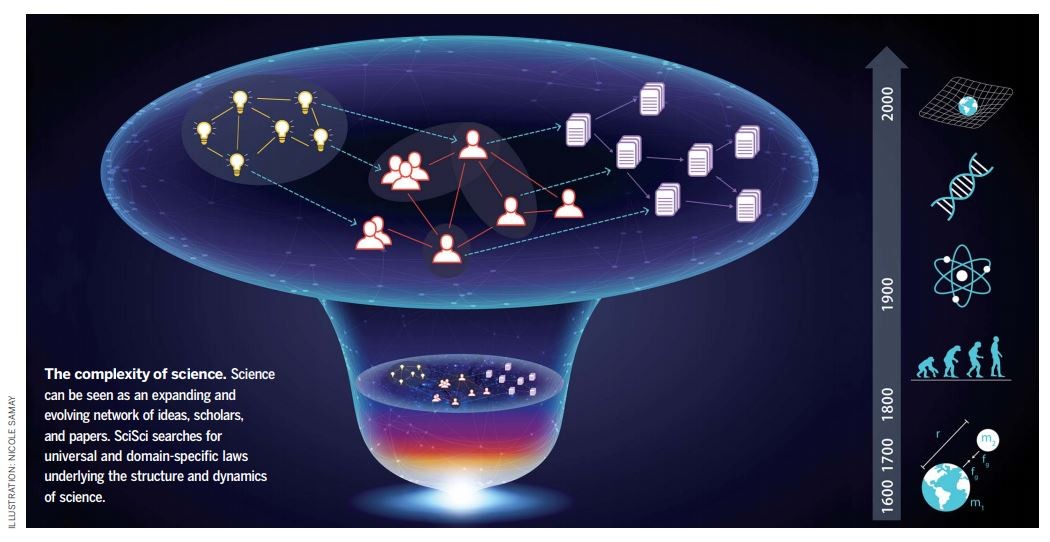博文
《科学》发表 科学学 综述论文
Science of Science一文的作者信息(长文下载见文后,正文共7页)
Santo Fortunato1,2,*, Carl T. Bergstrom3, Katy Börner(印第安纳大学教授,SCI2的开发者之一)2,4, James A. Evans5, Dirk Helbing6, Staša Milojević1, Alexander M. Petersen7, Filippo Radicchi1, Roberta Sinatra8,9,10, Brian Uzzi11,12, Alessandro Vespignani10,13,14, Ludo Waltman(莱顿大学研究员,VOSviewer开发者之一)15, Dashun Wang11,12, Albert-László Barabási8,10,16,*
注:Ludo Waltman来自科学计量学领域,他出生于1982年,在博士期间从事数理经济、博弈等方面的研究。他和VOSviewer的另一位开发者Nees,同时从Erasmus University Rotterdam博士毕业后,又同时正式入职了莱顿大学科学技术元勘中心。Ludo Waltman擅长数理模型及算法设计(目前主攻文献网络可视化和科学指标的开发),Nees擅长数据挖掘及软件开发(主攻科学数据可视化工具开发和算法设计)。他和Nees一起是目前欧洲科学计量学界的新星。Ludo Waltman目前也是国际知名期刊Journal of Informetrics的主编。2015年底到2016年初访问代尔夫特理工大学安全系时专程到莱顿大学的Centre for Science and Technology Studies拜访了Ludo 和Nees。
1Center for ComplexNetworks and Systems Research, School of Informatics, Computing, andEngineering, Indiana University, Bloomington, IN 47408, USA. 2Indiana University Network Science Institute, Indiana University,Bloomington, IN 47408, USA.3Department ofBiology, University of Washington, Seattle, WA 98195-1800, USA.4Cyberinfrastructure for Network Science Center, School of Informatics,Computing, and Engineering, Indiana University, Bloomington, IN 47408, USA.5Department of Sociology, University of Chicago, Chicago, IL 60637, USA.6Computational Social Science, ETH Zurich, Zurich, Switzerland.7Ernest and Julio Gallo Management Program, School of Engineering,University of California, Merced, CA 95343, USA.8Center for NetworkScience, Central European University, Budapest 1052, Hungary.9Department of Mathematics, Central European University, Budapest 1051,Hungary.10Institute forNetwork Science, Northeastern University, Boston, MA 02115, USA.11Kellogg School of Management, Northwestern University, Evanston, IL 60208,USA.12Northwestern Institute on Complex Systems, Northwestern University,Evanston, IL 60208, USA.13Laboratory for theModeling of Biological and Sociotechnical Systems, Northeastern University,Boston, MA 02115, USA.14ISI Foundation,Turin 10133, Italy.15Centre for Scienceand Technology Studies, Leiden University, Leiden, Netherlands.16Center for Cancer Systems Biology, Dana-Farber Cancer Institute, Boston,MA 02115, USA.
*Corresponding author. Email: santo@indiana.edu (S.F.); barabasi@gmail.com (A.-L.B.)
Science 02 Mar2018:
The complexity of science.
Science can be seen as an expanding and evolving network of ideas, scholars, and papers. SciSci searches for universal and domain-specific laws underlying the structure and dynamics of science.
Structured Abstract
BACKGROUND
The increasing availability of digital data on scholarly inputs and outputs—from research funding, productivity, and collaboration to paper citations and scientist mobility—offers unprecedented opportunities to explore the structure and evolution of science. The science of science (SciSci) offers a quantitative understanding of the interactions among scientific agents across diverse geographic and temporal scales: It provides insights into the conditions underlying creativity and the genesis of scientific discovery, with the ultimate goal of developing tools and policies that have the potential to accelerate science. In the past decade, SciSci has benefited from an influx of natural, computational, and social scientists who together have developed big data–based capabilities for empirical analysis and generative modeling that capture the unfolding of science, its institutions, and its workforce. The value proposition of SciSci is that with a deeper understanding of the factors that drive successful science, we can more effectively address environmental, societal, and technological problems.
ADVANCES
Science can be described as a complex, self-organizing, and evolving network of scholars, projects, papers, and ideas. This representation has unveiled patterns characterizing the emergence of new scientific fields through the study of collaboration networks and the path of impactful discoveries through the study of citation networks. Microscopic models have traced the dynamics of citation accumulation, allowing us to predict the future impact of individual papers. SciSci has revealed choices and trade-offs that scientists face as they advance both their own careers and the scientific horizon. For example, measurements indicate that scholars are risk-averse, preferring to study topics related to their current expertise, which constrains the potential of future discoveries. Those willing to break this pattern engage in riskier careers but become more likely to make major breakthroughs. Overall, the highest-impact science is grounded in conventional combinations of prior work but features unusual combinations. Last, as the locus of research is shifting into teams, SciSci is increasingly focused on the impact of team research, finding that small teams tend to disrupt science and technology with new ideas drawing on older and less prevalent ones. In contrast, large teams tend to develop recent, popular ideas, obtaining high, but often short-lived, impact.
OUTLOOK
SciSci offers a deep quantitative understanding of the relational structure between scientists, institutions, and ideas because it facilitates the identification of fundamental mechanisms responsible for scientific discovery. These interdisciplinary data-driven efforts complement contributions from related fields such as scientometrics and the economics and sociology of science. Although SciSci seeks long-standing universal laws and mechanisms that apply across various fields of science, a fundamental challenge going forward is accounting for undeniable differences in culture, habits, and preferences between different fields and countries. This variation makes some cross-domain insights difficult to appreciate and associated science policies difficult to implement. The differences among the questions, data, and skills specific to each discipline suggest that further insights can be gained from domain-specific SciSci studies, which model and identify opportunities adapted to the needs of individual research fields.
全文:http://science.sciencemag.org/content/359/6379/eaao0185/tab-pdf
https://blog.sciencenet.cn/blog-554179-1101932.html
上一篇:受托转载:Loss Prevention 2019 Symposium
下一篇:Andrew Hale中国行讲座之一[2016-10-22]
